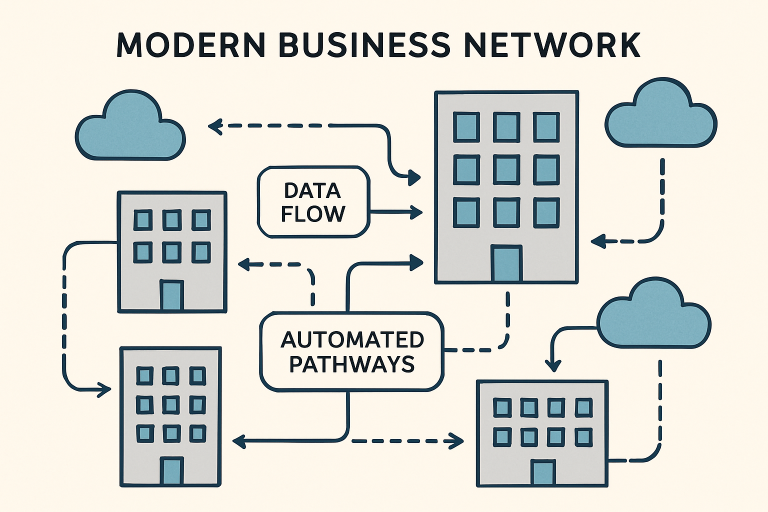Key Takeaways
- Smart connectivity is reshaping how organizations communicate and manage digital operations.
- Automated network management and dynamic traffic routing optimize performance and efficiency.
- Security solutions are evolving alongside connectivity enhancements to address new threats.
- Real-world business cases demonstrate measurable benefits from implementing smart networking strategies.
- Continuous learning and innovation are crucial for staying ahead in a connected world.
What Is Smart Connectivity?
In today’s hyperconnected business environment, high-speed internet alone is no longer sufficient for organizational growth or operational stability. Modern enterprises require network infrastructures that facilitate rapid data transfer and adapt proactively to evolving needs, security threats, and fluctuating demands. This is where smart connectivity comes into play—a transformative approach that uses advanced software, smart automation, and dynamic analytics to create agile, responsive, and resilient networks. Central to this transformation is the adoption of Secure SD-WAN, which empowers businesses to balance security and performance across distributed environments, seamlessly connecting headquarters, branch offices, and remote workers. Smart connectivity enables organizations to meet modern demands for reliable cloud access, streamlined remote collaboration, and consistent application performance by converging security, flexibility, and automation. It allows IT teams to move from legacy, manual network configurations to fully integrated, responsive systems that scale with business needs. In short, smart connectivity provides a foundation for sustainable digital transformation, fuelling smarter operations and accelerating innovation.
Benefits For Organizations Of All Sizes
Whether a small startup or a multinational enterprise, all businesses benefit from embracing smart network management. Reliable and resilient connectivity enables the digital tools that drive productivity—such as unified communications, CRM platforms, and data analytics dashboards. Smart connectivity ensures that these tools are consistently available, reducing costly downtime and empowering staff to collaborate wherever they are. Smart networking also streamlines IT operations by automating routine tasks, reducing operational complexity, and facilitating rapid troubleshooting. As a result, businesses can reallocate valuable IT resources from basic maintenance to strategic innovation, accelerating overall growth and resilience.
How Automated Network Management Works
At the heart of smart connectivity is network automation. Automated management tools continuously analyze traffic patterns, monitor device status, and adapt to real-time network conditions—all without human intervention. If an application is experiencing latency or bandwidth bottlenecks, the system can dynamically reallocate resources or reroute traffic to optimize speed and stability. These self-healing capabilities maximize uptime and minimize the risks associated with manual misconfigurations and extended troubleshooting sessions. For example, network managers can define policies to prioritize mission-critical apps, enforce granular access controls, and automatically respond to security incidents. As automation matures, artificial intelligence and machine learning can increasingly anticipate issues before they disrupt the business, driving a continuous improvement cycle.
Meeting Security Challenges Head-On
As connectivity evolves, so do the risks. Expanding networks and the proliferation of remote endpoints have widened the attack surface for today’s organizations. Smart networks proactively address these vulnerabilities with multi-layered defenses, including robust end-to-end encryption, zero trust principles, and real-time threat detection. Enterprises can establish consistent security policies across cloud, edge, and on-premises environments, reducing the likelihood of breaches even as data traverses complex multi-cloud architectures. Policy-based automation streamlines compliance efforts, ensuring that data privacy regulations are enforced without slowing down employees or critical systems. This advanced approach frees organizations from the limitations of legacy firewalls and static perimeter models while maintaining the speed and flexibility that modern operations require.
Real Life Business Network Transformations
Leading organizations across industries are already reaping the rewards of smart connectivity. For instance, a mid-sized retail chain leveraged dynamic bandwidth allocation to support massive spikes in online traffic during seasonal promotions, resulting in fewer lost sales and improved customer experiences. Automated network segmentation enables IT teams to safeguard sensitive patient data while granting doctors and nurses fast, secure access to digital records. These case studies highlight the tangible operational benefits—from improved sales performance to robust regulatory compliance—that arise when businesses invest in more innovative networking strategies.
Troubleshooting And Continuous Improvement
Even the most advanced smart networks demand vigilant oversight and adaptation. Modern management platforms with predictive analytics and machine learning swiftly detect anomalies, recommend remediation steps, and generate clear performance reports. By transforming raw network data into actionable insights, these tools empower IT teams to stay ahead of disruptions and continuously optimize infrastructure.
A commitment to ongoing improvement isn’t simply about resolving today’s issues—it’s about fostering long-term network health and keeping pace with evolving business needs. Adopting this proactive mindset is essential in ensuring that connectivity remains a business enabler, not a hurdle.
Next Steps: Implementing Smart Connectivity
The journey toward more innovative connectivity should start with a strategic pilot program. By selecting a contained network segment, organizations can assess new tools, measure performance improvements, and make data-driven decisions about broader adoption. Key to a smooth rollout is nurturing collaboration between business and IT teams and offering robust training so staff can fully leverage enhanced capabilities. Trusted third-party resources offer valuable perspectives to guide infrastructure planning and technology investments. Combining independent research with stakeholder feedback positions businesses for a successful transition.
Fostering A Culture Of Innovation
Embracing smart connectivity is not just a technical upgrade—it’s an organizational shift that signals a forward-thinking, agile business mindset. Successful companies anticipate shifts in connectivity needs, implement future-proof solutions, and invest regularly in evaluating new technologies. Creating a culture of innovation ensures competitiveness, allowing the organization to thrive even as digital landscapes rapidly evolve. The advantages of smart connectivity, from operational efficiency to bolstered security, continue to multiply as businesses refine their approach. Organizations are well-equipped to unlock the potential of an always-connected world by championing smart networking strategies and fostering continuous learning.

